Cheng Yongshun , the former deputy head and judge of the IP section of the Beijing High People’s Court, was among those invited to speak at a recent conference in Taipei, entitled, ‘The Development of Patent Invalidity Proceedings and Patent Litigation in Mainland China and how Taiwanese Businesses Should Respond’. Cheng is no stranger to Taiwan, as he’s previously taken part in cross-strait IP conferences from as early as 1995. This was his seventh visit to Taiwan.
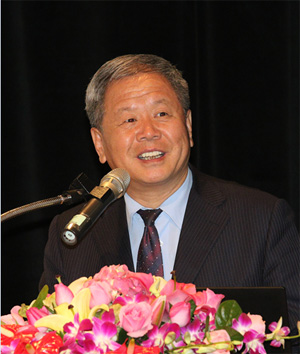
|
Director of the Beijing Intellectual Property Institute Cheng Yongshun |
Formerly serving as a judge and the deputy head of the IP section of the Beijing Higher People’s Court, Cheng was one of the first Chinese judges to work on IP cases, judging many landmark cases in his time on the bench.
In 2003 he was nominated by UK magazine Managing Intellectual Property as one of the fifty most influential people in IP in the world. |
Stable growth
The number of lawsuits in China from 2006 to 2016 has risen dramatically. Last year there were over 130,000 civil suits in China involving intellectual property, of which copyright cases saw the greatest growth. This growth is closely tied in with the rise of the internet and online infringement. Trademark cases have also shown growth over recent years with only patent infringement cases showing more stable growth, which sets off a stark contrast with the rapid growth in patent applications and licensing in the country. The reason for the relatively slow growth in patent litigation cases, according to Cheng, is that this trend more accurately reflects the current state of innovation and intellectual property protection in China.
Figure 1: The number of civil intellectual property suits accepted for hearing and concluded on first instance in China (2006-2016)
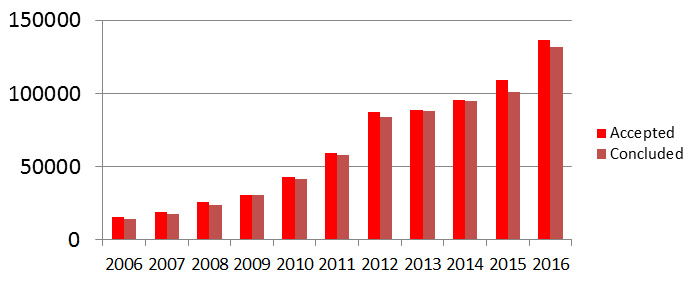
Source: Cheng Yongshun’s presentation
Figure 2: Types of intellectual property cases accepted for hearing on first instance in China (2006-2015)
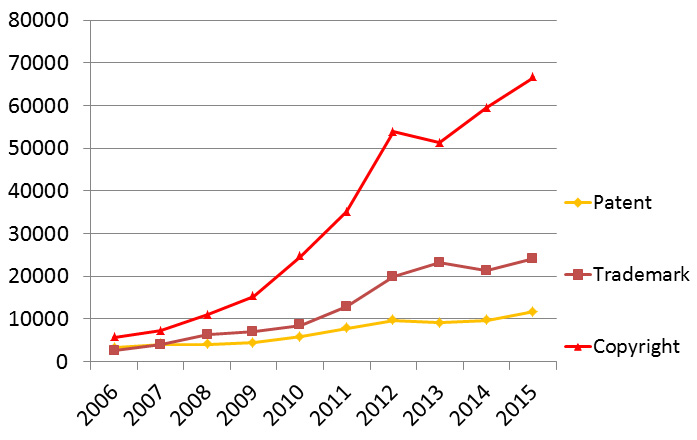
Source: Cheng Yongshun’s presentation
The number of courts with jurisdiction over patent lawsuits is quite high, but these are not distributed equally across all regions, with the lawsuits in Guangdong, Beijing, Jiangsu, Shanghai and Zhejiang making up 70% of all cases across China. China regulates the time taken to hear a case, with lawsuits on first instance being limited to six months, and those on second instance being limited to three months. According to the figures published by the Shanghai Intellectual Property Court, in 2016 they concluded 1,877 cases, with 94.14% of cases being concluded within the time limit. These time limits are being shortened further in China, and many cases end in settlements.
Cheng stated that although it's possible to adjudicate a trademark or copyright case in one or two months, the time limits are a little too short for patent and trade secret cases. Intellectual property lawyers and litigants in Beijing have complained of having to hold 3-4 sessions of court in half a day, suggesting that lawsuits may being concluded at too quick a pace.
China established the Beijing Intellectual Property Court on November 6, 2014, and the Guangzhou and Shanghai Intellectual Property Courts in December of the same year. Four intellectual property sections which have jurisdiction above and beyond the Intermediate People’s Courts in which they are housed were established in 2017 in Chengdu, Suzhou, Nanjing and Wuhan.
This is part of China's judicial reform program, with the IP sector serving as the frontline of this effort.
Table 1: China’s IP-related judicial reform measures
- Implementing a guidance system: previously each case was adjudicated independently; now, however, previously adjudicated cases can have an influence on active cases.
- Judge quotas: Judges need to be selected; only one of three of those qualified will be selected to serve as judges.
- Reduction of bureaucracy, the canceling of case reports and approvals: judges do not have to report to an upper court judge, the judge is responsible for their own decisions.
- The normalization of court presidents presiding over cases.
- Judges given autonomy in making their judgments.
- Similar to the Taiwan Intellectual Property Court, China has introduced technical advisors and expert advisors in IP cases.
- Similar to the US amicus curiæ system, the court listens to the opinions of experts.
- A trial of public collegiate bench verdicts with the majority deciding.
Source: Summary of Cheng Yongshun’s presentation
The above-listed judicial reform measures will end their three year trial period in August of this year, at which time the style of their permanent adoption will be decided.
Table 2: In 2017 China founded IP sections housed in Intermediate Courts in four Chinese cities
Date |
Function |
2017-1-9 |
The Chengdu Intellectual Property Court was founded: with jurisdiction over IP and anti-monopoly cases across Sichuan |
2017- 1-19 |
The Suzhou Intellectual Property Court was founded in the Suzhou New District, a specially designated region for technological and industrial development: it has jurisdiction over intellectual property cases in Suzhou, Wuxi, Changzhou and Nantong. |
2017-1-19 |
The Nanjing Intellectual Property Court was founded: with jurisdiction over all intellectual property cases from the neighboring region. |
2017-2-22 |
Wuhan Intellectual Property Court founded in the Donghu New Technology Development Zone: with jurisdiction over all intellectual property cases in Hubei province. |
Source: Cheng Yongshun’s presentation
No More Favorable Treatment for Foreign Corporations
Previously, to attract foreign capital, if foreign corporations (including those based in Hong Kong, Taiwan and Macao) faced patent litigation, normally the case would receive special attention. Foreign corporations had a 98% success rate in litigation in Zhejiang courts previously, for example. However, now China has begun to emphasize the fairness and efficiency of its intellectual property protections and has gradually tended towards a more rational approach which doesn't particularly treat foreign corporations more favorably.
The Main Problems with Patent Litigation in China
Problem 1: Chaotic Jurisdiction System
China has Basic, Intermediate and Higher People's Courts, in addition to the Supreme People's Court. Until the end of 2014, there were 32 Higher People's Courts with jurisdiction over patent cases; however, among the 404 Intermediate People's Courts in China, only 87 were able to hear utility model and design patent cases; and among the 3000 Basic People's Courts, only 10 were able to hear some kinds of patent cases. This means that the jurisdiction system in China is overly complex, so much so that even judges can be unclear if they have jurisdiction or not, according to Cheng.
For example, although China has dedicated intellectual property courts, the Guangzhou cannot hear patent cases from Shenzhen; and now there are also individual intellectual property courts with jurisdiction beyond the courts in which they are housed, and some of these are housed in Intermediate People's Courts, while others are housed in Basic People's Courts. Not only this, but if the plaintiff is demanding a larger sum in damages, Basic or Intermediary People's Courts, and must be handed over to High People's Courts for judgment.
Problem 2: Lack of consistency in Judgments
Although China has been making a significant effort to increase intellectual property protection, judgments vary widely and are inconsistent. Different district courts aren't consistent, nor are higher and lower courts, and there can even be inconsistency between different individual courts in the same court building.
Last year the Intellectual Property Section of China's Supreme People's Court heard 724 intellectual property cases of all kinds. Among them, 99 were judicial review cases, with 601 cases of a retrial due to an appeal of the original verdicts (third instance). Cheng stated, that the wide gap between cases of which the Supreme Court chose to review and retrials was so big because Chinese people are dissatisfied with the verdicts issued them. Although many cases are very quickly dispatched, the majority end up in mediation, with only a minority going to the verdict stage. Now the number of appeals is getting larger, suggesting that litigants will keep on appealing to the end due to the inconsistency in judgments.
Problem 3: Low Damages
Cheng stated that the most difficult aspects of intellectual property protection center around two issues: judging if infringement occurred, and how damages should be calculated if infringement is established. According to figures in China's draft amendment to its patent law, patent holders currently get around 36% of the damages they seek, with damages averaging at just RMB80,000 (US$11,600); According to a sample of 100 second instance patent infringement cases at the Beijing Higher People's Court, 65 involved a dispute over damages, the average damages were RMB210,000 (US$30,470). There has already been a rebound to the amount of damages awarded in Chinese courts, but what level of damages is appropriate? Currently this is a controversial issue.
Future Trends for Chinese Patent Litigation
In April 24, 2017, the Supreme People's Court published the first Outline for Juridical Protection of Intellectual Property Rights in China (2016-2020), and they are actively engaged in amending all related laws and regulations. With courts in different regions comparing patent judgments, the time limits for patent cases will be reduced once again, and damages will get higher. In 2015 the Beijing Intellectual Property Court awarded average damages of RMB450,000 (US$65,300) in patent infringement cases, and average damages of RMB1.4 million (US$203,150) in patent infringement cases in 2016, while trademark infringement cases saw average damages of RMB1.7 million (US$246,680) and copyright cases saw average damages of RMB458,000 (US$66,460). Chinese courts have also lowered the bar in terms of the requirements for a preservation of evidence order in advance of proceedings. China has also learned from Taiwan's example in promoting three-in-one (civil, criminal and administrative) proceedings in the same court. Currently more than a dozen Higher People's Courts in China are putting three-in-one proceedings into practice.
Six Pieces of Advice for Foreign Companies in Patent Litigation in China
From its founding until the end of February 2017, the Beijing Intellectual Property Court has heard 3,693 cases, among which 20% involved patent cases from foreign litigants (including Taiwan, Hong Kong and Macao). Cheng had six tips for foreign patent litigants in China.
Figure 3: Cheng Yongshun
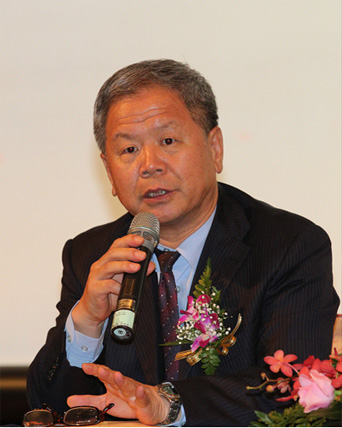 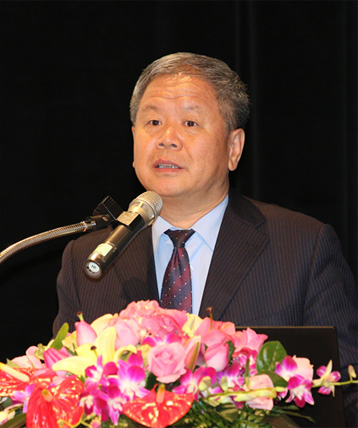
Photograph by Tommy Tang
1. Secure patent rights are the foundation for success in litigation and judicial protection
Compared to Taiwan and Japan, invalidation cases in Beijing are still relatively low, and in patent infringement cases across the whole of China, the rate of success for plaintiffs is at least 55%, but Chinese courts are getting stricter in their interpretations, if you don't have secure patent rights, it will be harder and harder to get intellectual property protection in China.
Good patents don't just conform with the requirements for patentability, nor is it just about getting patent rights, the most important thing is a clear and appropriate scope of protection for your patent rights, and secure rights. Before the litigation, it's best to do an analysis of the stability of the patent rights, so it's best not to put all your faith in a patent evaluation report, and ensure the scope of the claims. If your scope of protection is unclear, the defendant may be judged not to be infringing.
2. Choosing a patent agent
There is a big difference in quality between different litigators in China, so you should choose a diligent and responsible agent with good legal knowledge and experience in front of a judge. As this has a big influence on whether or not you'll be able to secure protection for your intellectual property.
3. Choose a favorable venue for civil patent suits, for administrative cases make sure to sift through previous cases:
Chinese courts are advocating a system of precedents, so if you want to file a civil patent suit, you should first do a comparison between different courts, and research the judicial position of the court and its verdicts. Only then will you be able to choose the right court; for administrative cases, do your best to sift through cases for precedents.
4. Make ample preparation to collect evidence and carry out an infringement analysis:
In many situations, the same technology doesn't always indicate infringement and if the technology differs it doesn't always mean that it's not infringing. When the patent holder discovers infringement, they are often very confident in themselves, convinced that the other party is implementing their patent, but after careful analysis, they discover that there are differences in the technology. Cheng stated that patent holders shouldn't be overly confident in their judgment of infringement, as they should carry out an analysis rather than relying on their own judgment. When collecting evidence, one has to be prepared, objective and thorough, and make use of public notarization; when carrying out infringement analysis, one should be objective, and, if possible, it's best to get a third party to carry it out on your behalf.
5. Make the most of current Chinese laws and use them well:
You should learn to use Chinese law to your advantage. Foreign companies have still a lot to learn in this respect. For example, you should make good use of tactics such as pre-litigation injunctions, attachment of property and preservation of evidence; Last year the Shanghai Intellectual Property Court conducted 30 pre-trial preservation orders, growth of 114.28% on 2015. In addition, you shouldn't send out warning letters without due consideration, to avoid malicious suits, and at the same time prevent other parties from launching litigation to confirm non-infringement.
6. Adjust your strategy in a timely way, and choose your time to settle or enter mediation
Some patent holders are very familiar with their patent so they think that they have a big probability of prevailing, and in the process of litigation they are very insistent on their own view, and aren't willing to adapt their strategy with changes in the hearing of the lawsuit. This isn't rational behavior. If the protection of the patent is not secure or the scope is not clear, infringement is hard to establish and it's always best to settle or go into mediation.
 |
|
| Author: |
Conor Stuart |
| Current Post: |
Senior Editor, IP Observer |
| Education: |
MA Taiwanese Literature, National Taiwan University
BA Chinese and Spanish, Leeds University, UK |
| Experience: |
Translator/Editor, Want China Times
Editor, Erenlai Magazine |
|
|
|
| Facebook |
|
Follow the IP Observer on our FB Page |
|
|
|
|
|
|

